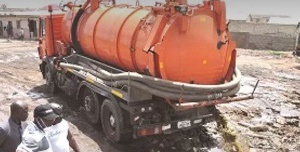- Home - News
- TWI News | TV
- Polls
- Year In Review
- News Archive
- Crime & Punishment
- Politics
- Regional
- Editorial
- Health
- Ghanaians Abroad
- Tabloid
- Africa
- Religion
- Election 2020
- Coronavirus
- News Videos | TV
- Photo Archives
- News Headlines
- Press Release
Business News of Sunday, 14 January 2018
Source: newsghana.com
Ghanaian firm introduces scientific approach to liquid waste management
Increased population growth and rapid urbanization have resulted in increased generation of volumes of both solid and liquid waste in the cities.
According to the Greater Accra Metropolitan Area (GAMA) World Bank-funded sanitation and water project, 26, 000 cubic meters of waste is generated in Ghana’s national capital Accra per day.
To help solve this challenge in Accra, Sewerage Systems Ghana Limited, a waste management company, has put up a Septage tank treatment plant, the Lavender Hill and Mudor Fecal Treatment Plant, in Accra to ensure proper and efficient sewerage disposal.
The 40 million U.S. dollars ultra-modern plant, constructed by experts from China’s Nanjing Wonder Environment Technology Company, has the capacity to receive 80 per cent of the entire human waste generated in Accra.
It is currently receiving between 200 and 250 trucks of human waste daily and has been designed by the Chinese experts for a lifespan of 20 years.
Prior to its construction in 2013 and commissioning in 2016, the city practiced primitive method of disposing of fecal waste where cesspit emptiers are directly emptied into the ocean, posing both health and environmental problems.
“Before we started our operations, liquid waste for almost 100 years was being discharged into the ocean just across the street here without any form of treatment but the Jospong Group found it expedient to put up a plant that will treat the liquid waste before discharging to the ocean,” Florence Cobold, General Manager of the company, told Xinhua in an interview.
The plant, first of its kind in the sub-region, consists of a primary treatment stage which includes screening, primary settling, raw Septage and sludge dewatering.
A secondary treatment stage includes anaerobic digestion (UASB), anoxic-oxic digestion and secondary setting while a tertiary treatment phase comprise of ultra violet disinfection; biogas utilization, digested sludge dewatering.
The plant also comprises of a modern laboratory which tests both the influent and the effluent qualities of waste water. The final effluent is pumped back into the system for reuse in the plant.
The solid materials generated through the system are used for compost manure while the biogas generated is harnessed and used as a source of alternative energy for the plants.
The Lavender Hill and Mudor Fecal Treatment Plant which is using Chinese technology has been enjoying high patronage since its full operation early this year.
Lola Asiseh Ashitey, the Business Development Manager of the SSGL, said her outfit was excited by the kind of work it does because it is a serious project that saves lives.
“We are encouraging people to make sure that when their fecal sludge is dislodged from their homes it is sent to the right place for treatment so that we can live in a healthier community,” she said. Enditem











